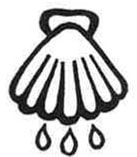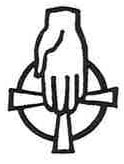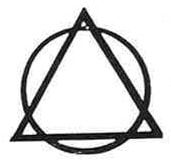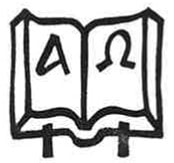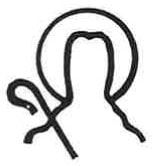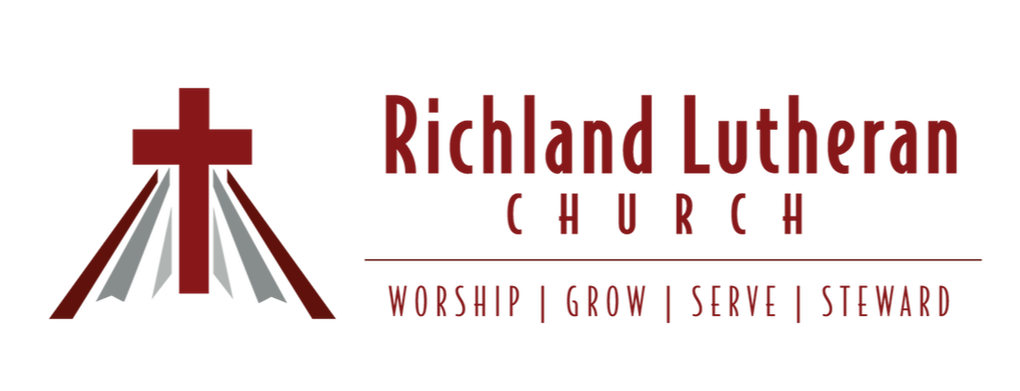More Than Concrete and Stone
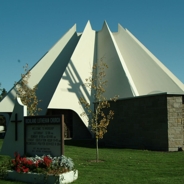
Could concrete and stone voice a call to worship? Could it communicate the Gospel of Jesus Christ? Could the very architecture of a church announce expectancy and hope? It was the determination of Richland Lutheran Church, where the desert meets three rivers - the Columbia, the Yakima and the Snake, that such would be their goal. Their longing for a worshipful atmosphere within the sanctuary and an exterior that would be a constant witness to Christ was fulfilled through the architectural firm of Funk, Murray and Johnson, Spokane, Washington.
The message of the church is conveyed through the exterior shape of the building, which is designed to resemble a tent, reminding the community of the tent of meeting of the Old Testament, speaking of God's presence among His people. The tent shape is also a reminder that we have no permanent dwelling on this earth. The Christian looks forward to heaven as his homeland.
On the two opposite outside doors entering the narthex can be seen some unusual iron artwork. The door on the east bears the Good Shepherd design while the western door depicts Martin Luther nailing the ninety-five theses to the cathedral door. The excellence of their workmanship is shown in that each is worked from one single piece of metal.
As one enters the sanctuary he is aware of an uplifting thrust carried out in the clean lines of the "tent of the tabernacle" with its 24 sloping roof panels resting on twelve foundation points which symbolize both the Old Testament twelve tribes of Israel and the New Testament twelve apostles. The twelve peaks point Heavenward, while their concrete and stone composition bespeak a permanent relation to a God of steadfast and everlasting love.
Reminiscent of the three crosses of Calvary, three hanging crosses descend from the "starry vault" of the nave's dome as the symbol of salvation. The center Christ cross depicts in the two circles the Christ who is holy and eternal - the inner circle, the nimbus, for holiness and the outer circle for eternity. The Chi-Rho (the Greek initials for Christ) are inside the inner circle. The red cross indicates His shed blood and the anchor typifies the hope of the world. The cross to the right with its inner white cross represents those who receive Christ and are made "white in the blood of the lamb." The cross to the left with its inner black cross symbolizes those who, rejecting Christ, are still in their sins.
In the fan-shaped seating arrangement there is emphasis given to the belief in the universal priesthood ofall believers, encouraging the "participate relationship" of all worshipers rather than the "spectator relationship." Both the choir and the pastors share in this relationship - the choir, visible to the congregation, is a part of the worshipping congregation and the pastors, seated in clergy chairs with the congregation, come forward out of the congregation that has called them.
The design of the chancel features a free-standing altar that permits the pastor to serve behind the altar, facing the congregation and looking up to the crosses hanging from the center of the dome. The pulpit is directly behind the altar, against the chancel wall, placing it back far enough so that the pastor can maintain eye contact with all worshipers. A slightly sloping floor in the nave assures good sight lines for all worshipers. This clear view of the chancel permits awareness of the Means of Grace - the ministry of Word at Altar and Pulpit and the ministry of Sacraments at the Baptismal Font and Communion Rail. One focus of attention is the pulpit grill with open bronze work inscription: "The Seed is the Word of God." Dr. A. R. Kretzman, eminent authority on church architecture, was asked to suggest something particularly appropriate for this church. He suggested the parable of the sower as a theme text for the congregation, with the seed (Word of God) falling into good soil (rich land) and growing to produce fruit in the lives of people. This plant and vine motif, beginning at the top with small spouts, in the pulpit grill, carries downward, over into the metal work at the base of the altar, thence into the lectern on the right side of the altar and into the baptismal font on the left.
The pulpit grill also contains the everlasting light in its clear glass container. The symbols for the four Gospel writers seen on both sides of the pulpit have their origin in the prophet Ezekiel. On this grooved walnut backdrop are engraved Ezekiel's pictures of the winged creatures typifying the Four Evangelists. The winged man who is exalted above all creatures represents Matthew and signifies the human nature of our Lord. Mark is represented by the winged lion - the king of the beasts of the field and denotes royalty. The winged ox - king of the domestic animals - symbolizes Luke and his stress upon the sacrificial death of our Lord. The Gospel of John, the winged eagle, king of the birds of the air, "soars on eagles' wings to the very throne of Heaven." These are vehicles to convey the revelation of the Holy One of Israel who is sovereign Lord. Thus in the backdrop two Gospel symbols on each side of the pulpit point toward Him who is the Living Word. As a beautiful background for the eternal flame, in the sides and grill of the pulpit are the paraments whose five colors are changed according to the church year.
The altar is of white Italian marble. Both the altar and the communion rail are in the fish shape, which was used by the early persecuted Christians as a secret sign of recognition. The five letters of the Greek word 'ichthus' spelling the word 'fish' are the first letters of the Greek words "Jesus Christ, God's Son, Saviour." The same "ichthus" symbol appears in the five Greek letters worked in bronze on the Gothic-shaped double doors of the nave. As the worshiper enters the nave through these doors spelling salvation he also passed under the Agape Light which has the Greek words "Love One Another" cut into it. The cutwork on this light shows the Trinity symbol above and the cross below.
As one turns his attention to the chancel, he sees the Eucharist lights to the right and left of the altar. These symbolize the divine and the human in Christ. A lower crown of suffering depicts His humiliation and a victory crown at the top of each light bespeaks His exaltation. Incised into each victory crown are the symbols for the three enduring possessions: the cross for faith, the anchor for hope, and the heart for love.
The baptismal font tells the story of man's life in its four seasons. On the front side, we see infancy and early childhood in the sprouting plants with buds. On the second side, we see youth - the growing and unfolding time of life - in the leafing-out stage. The third side of the font represents the mature years -the fruit bearing time of life - living in the way of the Cross. Here there is fruit on the plants. The fourth side represents the Old Age time of life. The branches are stick-like, without leaves, but there is both storehouse and fruit - fruit in terms of eternity gathered into the storehouse.
The communion rail is in "ichthus" shape. Inlaid at alternating intervals, on the top of the communion rail are bronze discs. One circle contains the three Greek letters Iota Eta Sigma (sometimes called "IHS") which are the abbreviation for "Jesus" in Greek. The alternating symbol shows the stalk of wheat and the vine, representing the bread and wine.
The ninety-six foot Gospel Tower suggests a giant cross. It bears a concrete cross with the Chi Rho symbol above the horizontal and the Alpha Omega below, speaking the message that the risen Christ of the empty cross is the beginning and the end.
The stained glass windows in the main sanctuary were created to translate ideas by a medium of thick glass set in epoxy, artistically. An explanation of each window is given on a plaque mounted beside it. The window titles are: The Triune Window, The Creation/Fall-Promise Window, The Covenant/Promise Window, The Gospel Window, The Life Everlasting Window, The Dove Window, and The Father-Son Window.
Interesting Statistics
The message of the church is conveyed through the exterior shape of the building, which is designed to resemble a tent, reminding the community of the tent of meeting of the Old Testament, speaking of God's presence among His people. The tent shape is also a reminder that we have no permanent dwelling on this earth. The Christian looks forward to heaven as his homeland.
On the two opposite outside doors entering the narthex can be seen some unusual iron artwork. The door on the east bears the Good Shepherd design while the western door depicts Martin Luther nailing the ninety-five theses to the cathedral door. The excellence of their workmanship is shown in that each is worked from one single piece of metal.
As one enters the sanctuary he is aware of an uplifting thrust carried out in the clean lines of the "tent of the tabernacle" with its 24 sloping roof panels resting on twelve foundation points which symbolize both the Old Testament twelve tribes of Israel and the New Testament twelve apostles. The twelve peaks point Heavenward, while their concrete and stone composition bespeak a permanent relation to a God of steadfast and everlasting love.
Reminiscent of the three crosses of Calvary, three hanging crosses descend from the "starry vault" of the nave's dome as the symbol of salvation. The center Christ cross depicts in the two circles the Christ who is holy and eternal - the inner circle, the nimbus, for holiness and the outer circle for eternity. The Chi-Rho (the Greek initials for Christ) are inside the inner circle. The red cross indicates His shed blood and the anchor typifies the hope of the world. The cross to the right with its inner white cross represents those who receive Christ and are made "white in the blood of the lamb." The cross to the left with its inner black cross symbolizes those who, rejecting Christ, are still in their sins.
In the fan-shaped seating arrangement there is emphasis given to the belief in the universal priesthood ofall believers, encouraging the "participate relationship" of all worshipers rather than the "spectator relationship." Both the choir and the pastors share in this relationship - the choir, visible to the congregation, is a part of the worshipping congregation and the pastors, seated in clergy chairs with the congregation, come forward out of the congregation that has called them.
The design of the chancel features a free-standing altar that permits the pastor to serve behind the altar, facing the congregation and looking up to the crosses hanging from the center of the dome. The pulpit is directly behind the altar, against the chancel wall, placing it back far enough so that the pastor can maintain eye contact with all worshipers. A slightly sloping floor in the nave assures good sight lines for all worshipers. This clear view of the chancel permits awareness of the Means of Grace - the ministry of Word at Altar and Pulpit and the ministry of Sacraments at the Baptismal Font and Communion Rail. One focus of attention is the pulpit grill with open bronze work inscription: "The Seed is the Word of God." Dr. A. R. Kretzman, eminent authority on church architecture, was asked to suggest something particularly appropriate for this church. He suggested the parable of the sower as a theme text for the congregation, with the seed (Word of God) falling into good soil (rich land) and growing to produce fruit in the lives of people. This plant and vine motif, beginning at the top with small spouts, in the pulpit grill, carries downward, over into the metal work at the base of the altar, thence into the lectern on the right side of the altar and into the baptismal font on the left.
The pulpit grill also contains the everlasting light in its clear glass container. The symbols for the four Gospel writers seen on both sides of the pulpit have their origin in the prophet Ezekiel. On this grooved walnut backdrop are engraved Ezekiel's pictures of the winged creatures typifying the Four Evangelists. The winged man who is exalted above all creatures represents Matthew and signifies the human nature of our Lord. Mark is represented by the winged lion - the king of the beasts of the field and denotes royalty. The winged ox - king of the domestic animals - symbolizes Luke and his stress upon the sacrificial death of our Lord. The Gospel of John, the winged eagle, king of the birds of the air, "soars on eagles' wings to the very throne of Heaven." These are vehicles to convey the revelation of the Holy One of Israel who is sovereign Lord. Thus in the backdrop two Gospel symbols on each side of the pulpit point toward Him who is the Living Word. As a beautiful background for the eternal flame, in the sides and grill of the pulpit are the paraments whose five colors are changed according to the church year.
The altar is of white Italian marble. Both the altar and the communion rail are in the fish shape, which was used by the early persecuted Christians as a secret sign of recognition. The five letters of the Greek word 'ichthus' spelling the word 'fish' are the first letters of the Greek words "Jesus Christ, God's Son, Saviour." The same "ichthus" symbol appears in the five Greek letters worked in bronze on the Gothic-shaped double doors of the nave. As the worshiper enters the nave through these doors spelling salvation he also passed under the Agape Light which has the Greek words "Love One Another" cut into it. The cutwork on this light shows the Trinity symbol above and the cross below.
As one turns his attention to the chancel, he sees the Eucharist lights to the right and left of the altar. These symbolize the divine and the human in Christ. A lower crown of suffering depicts His humiliation and a victory crown at the top of each light bespeaks His exaltation. Incised into each victory crown are the symbols for the three enduring possessions: the cross for faith, the anchor for hope, and the heart for love.
The baptismal font tells the story of man's life in its four seasons. On the front side, we see infancy and early childhood in the sprouting plants with buds. On the second side, we see youth - the growing and unfolding time of life - in the leafing-out stage. The third side of the font represents the mature years -the fruit bearing time of life - living in the way of the Cross. Here there is fruit on the plants. The fourth side represents the Old Age time of life. The branches are stick-like, without leaves, but there is both storehouse and fruit - fruit in terms of eternity gathered into the storehouse.
The communion rail is in "ichthus" shape. Inlaid at alternating intervals, on the top of the communion rail are bronze discs. One circle contains the three Greek letters Iota Eta Sigma (sometimes called "IHS") which are the abbreviation for "Jesus" in Greek. The alternating symbol shows the stalk of wheat and the vine, representing the bread and wine.
The ninety-six foot Gospel Tower suggests a giant cross. It bears a concrete cross with the Chi Rho symbol above the horizontal and the Alpha Omega below, speaking the message that the risen Christ of the empty cross is the beginning and the end.
The stained glass windows in the main sanctuary were created to translate ideas by a medium of thick glass set in epoxy, artistically. An explanation of each window is given on a plaque mounted beside it. The window titles are: The Triune Window, The Creation/Fall-Promise Window, The Covenant/Promise Window, The Gospel Window, The Life Everlasting Window, The Dove Window, and The Father-Son Window.
Interesting Statistics
- Each panel contains nine cubic yards or 14 tons of concrete; each is 65 feet long and 740 square feet in area.
- There is a total of one mile of steel tension cable in the panels.
- The Gospel Tower is 96 feet tall; to support it, there are 127 tons of concrete below ground. The tower itself weighs 34 tons.
- The total roof system, including the stone, weighs 500 tons.
Christian Life Symbols
Along the wall behind the chancel, there are twelve embossed symbols representing the life of the Christian:

